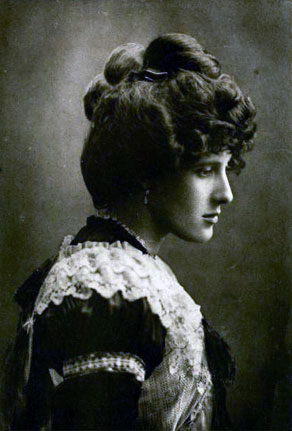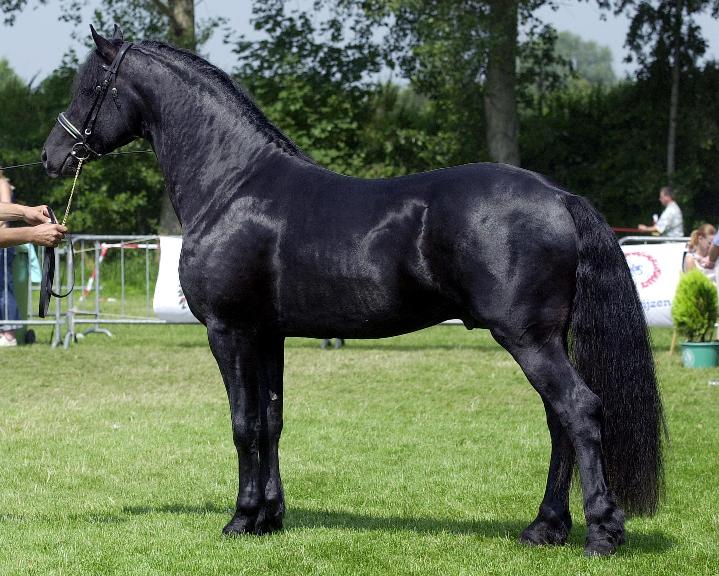|
Welara
The Welara is a part-Arabian horse breed, pony breed developed from the Arabian horse and the Welsh pony. It was originally bred in England by Lady Wentworth at the Crabbet Arabian Stud in the early 1900s from imported Arabian stallions and Welsh pony mares. Breeding then spread throughout North America. In 1981, a breed registry was formed in the United States, and a studbook began to be published. They are used for many disciplines of English riding, and are known for their refinement, hardiness and spirit. Breed characteristics Welara stallions average and mares . To be registered, Welaras must stand between high. Crosses between Arabians and each of the four sections of Welsh Pony (A, B, C and D) tend to produce slightly different types of pony. Section A Welsh Pony crosses (the smallest) tend to be under , and be used mainly as light driving ponies and mounts for small children. Section B crosses usually stand and can be used for driving and as riding ponies for larger ... [...More Info...] [...Related Items...] OR: [Wikipedia] [Google] [Baidu] |
Arabian Horse
The Arabian or Arab horse ( , DIN 31635, DMG ''al-ḥiṣān al-ʿarabī'') is a horse breed, breed of horse with historic roots on the Arabian Peninsula. With a distinctive head shape and high tail carriage, the Arabian is one of the most easily recognizable horse breeds in the world. It is also one of the oldest modern breeds. Although modern DNA cannot trace breed purity in the modern population beyond 200 years, there is archaeological evidence of horses in the Middle East with landrace characteristics that resemble modern Arabians dating back 3,500 years. Arabian horses have spread around the world by both war and trade, being used to improve other breeds by adding speed, refinement, endurance, and strong bone. Today, Arabian bloodlines are found in almost every modern breed of riding horse. The Arabian developed in a desert climate and was prized by the nomadic Bedouin people, often being brought inside the family tent for shelter and protection from theft. Selective ... [...More Info...] [...Related Items...] OR: [Wikipedia] [Google] [Baidu] |
Welsh Pony
The Welsh Pony and Cob is a group of four closelyrelated horse breeds including both pony and cob (horse), cob types, which originated in Wales. The four sections within the breed registry, breed society for the Welsh breeds are primarily distinguished by height, and also by variations in type: the smallest Welsh Mountain Pony (Section A); the slightly taller but refined Welsh Pony of riding type (Section B) popular as a children's show horse, show mount; the small but stocky Welsh Pony of Cob Type (Section C), popular for riding and competitive driving; and the tallest, the Welsh Cob (Section D), which can be ridden by adults. Welsh ponies and cobs in all sections are known for their good temperament, hardiness, and free-moving Horse gaits, gaits. Native ponies existed in Wales before 1600 BC, and a Welsh-type cob was known as early as the Middle Ages. They were influenced by the Arabian horse, and possibly also by the Thoroughbred and the Hackney (horse), Hackney horse. In 19 ... [...More Info...] [...Related Items...] OR: [Wikipedia] [Google] [Baidu] |
Part-Arabian
A part-Arabian, partbred Arabian or, less precisely, half-Arabian, is a horse with documented amounts of Arabian horse breeding but not a purebred. Because the Arabian is deemed to be a breed of purebred horse dating back many centuries, the modern breed registries recognized by the World Arabian Horse Organization generally have tightly closed stud books which exclude a horse from registration if it is found to contain any outside blood. However, Arabian breeding has also been used for centuries to add useful traits to countless other horse breeds. In the modern era, crossbreeding has been popular to combine the best traits of two different breeds, such as color, size, or ability to specialize in a particular equestrian discipline. Thus, in the modern era, the desire to recognize and acknowledge Arabian breeding in non-purebred horses has led to the formation of partbred sections in many purebred Arabian registries in order to record the pedigrees of crossbreds. Some registri ... [...More Info...] [...Related Items...] OR: [Wikipedia] [Google] [Baidu] |
Lady Wentworth
Judith Anne Dorothea Blunt-Lytton, 16th Baroness Wentworth (6 February 1873 – 8 August 1957), also known as Lady Wentworth, was a British peeress, Arabian horse breeder and real tennis player. As the owner of the Crabbet Arabian Stud from 1917 to 1957, her influence on Arabian horse breeding was profound, with over 90 per cent of all Arabian horses in the world today carrying lines to Crabbet bloodstock in their pedigrees. Early life and family Judith was the only surviving child of the poet Wilfrid Scawen Blunt and his wife, Lady Anne, a daughter of William King-Noel, 1st Earl of Lovelace, and his wife, the renowned mathematician Ada Lovelace. Therefore, she was also the great-granddaughter of Lord Byron. Judith spent most of her childhood in Egypt and other parts of the Middle East while her parents travelled to purchase Arabian horses for their Crabbet Arabian Stud back in England and their Sheykh Obeyd stud in Cairo. Thus, the family was familiar with middle eastern cult ... [...More Info...] [...Related Items...] OR: [Wikipedia] [Google] [Baidu] |
England
England is a Countries of the United Kingdom, country that is part of the United Kingdom. It is located on the island of Great Britain, of which it covers about 62%, and List of islands of England, more than 100 smaller adjacent islands. It shares Anglo-Scottish border, a land border with Scotland to the north and England–Wales border, another land border with Wales to the west, and is otherwise surrounded by the North Sea to the east, the English Channel to the south, the Celtic Sea to the south-west, and the Irish Sea to the west. Continental Europe lies to the south-east, and Ireland to the west. At the 2021 United Kingdom census, 2021 census, the population was 56,490,048. London is both List of urban areas in the United Kingdom, the largest city and the Capital city, capital. The area now called England was first inhabited by modern humans during the Upper Paleolithic. It takes its name from the Angles (tribe), Angles, a Germanic peoples, Germanic tribe who settled du ... [...More Info...] [...Related Items...] OR: [Wikipedia] [Google] [Baidu] |
Sussex, England
Sussex ( /ˈsʌsɪks/; from the Old English ''Sūþseaxe''; lit. 'South Saxons'; 'Sussex') is an area within South East England that was historically a kingdom and, later, a county. It includes the ceremonial counties of East Sussex and West Sussex. The area borders the English Channel to the south, and the ceremonial counties of Surrey to the north, Kent to the north-east, and Hampshire to the west. Sussex contains the city of Brighton and Hove and its wider city region, as well as the South Downs National Park and the National Landscapes of the High Weald and Chichester Harbour. Its coastline is long. The Kingdom of Sussex emerged in the fifth century in the area that had previously been inhabited by the Regni tribe in the Romano-British period. In about 827, shortly after the Battle of Ellendun, Sussex was conquered by Wessex. From 860 it was ruled by the kings of Wessex, and in 927 it became part of the Kingdom of England. By the Norman period, Sussex was subdivide ... [...More Info...] [...Related Items...] OR: [Wikipedia] [Google] [Baidu] |
Pleasure Driving
Pleasure driving is a horse show class seen in the United States, which features light breeds of horses and ponies hitched to a two or four-wheeled show cart. Horses are driven at a walk and two speeds of trot, generally designated as a working or regular trot and an extended "strong" trot. Many horse breeds compete in Pleasure driving. Most classes are judged on the horse's manners, performance, quality and conformation. See also * Horse harness * Fine harness Fine harness is a type of driving (horse), driving competition seen at horse shows, that feature light, refined horses with high action. Popular horse breed, breeds in this event include the American Saddlebred, Morgan horse, Morgan, Arabian h ... References Equestrianism Horse driving Sources=http://www.australiancarriagedrivingsocietyvic.org.au/ {{equestrian-stub ... [...More Info...] [...Related Items...] OR: [Wikipedia] [Google] [Baidu] |
Thoroughbred
The Thoroughbred is a list of horse breeds, horse breed developed for Thoroughbred racing, horse racing. Although the word ''thoroughbred'' is sometimes used to refer to any breed of purebred horse, it technically refers only to the Thoroughbred breed. Thoroughbreds are considered "Hot-blooded horse, hot-blooded" horses that are known for their agility, speed, and spirit. The Thoroughbred, as it is known today, was developed in 17th- and 18th-century England, when native mares were Crossbreed, crossbred with imported stallion (horse), stallions of Arabian horse, Arabian, Barb horse, Barb, and Turkoman horse, Turkoman breeding. All modern Thoroughbreds can trace their pedigrees to three stallions originally imported into England in the 17th and 18th centuries, and to a larger number of foundation bloodstock, foundation mares of mostly English breeding. During the 18th and 19th centuries, the Thoroughbred breed spread throughout the world; they were imported into North America ... [...More Info...] [...Related Items...] OR: [Wikipedia] [Google] [Baidu] |
Stud Farm
A stud farm or stud in animal husbandry is an establishment for selective breeding of livestock. The word "stud (animal), stud" comes from the Old English ''stod'' meaning "herd of horses, place where horses are kept for breeding". Historically, documentation of the breedings that occur on a stud farm leads to the development of a stud book. Male animals made available for breeding to outside female animals are said to be "standing at stud", or at "stud service". The word stud is often restricted to larger domesticated (especially farm) animals, such as cattle and horses. A specialized vocabulary exists for the studs of other animals, such as kennel (dog), cattery (cat) and aviary (birds). Horse stud farms Monastic stud farms During the Middle Ages, stud farms were often managed as part of a monastery. At the time, few people apart from monks could read and write, and so they were charged with the responsibility of recording Pedigree chart, pedigrees. The Carthusian monks are ... [...More Info...] [...Related Items...] OR: [Wikipedia] [Google] [Baidu] |
Skowronek (horse)
Skowronek (a name meaning ''lark'' or ''skylark'' in Polish) was an Arabian stallion foaled in 1908 or 1909. He was bred by Count Józef Potocki who owned the Antoniny Stud in Poland. He was imported to England as a young horse. Upon purchase by Lady Wentworth, Skowronek became a foundation stallion at Lady Wentworth's Crabbet Arabian Stud. He was most often crossed on mares who were daughters or granddaughters of the stallion Mesaoud, another foundation stallion for Crabbet, who had been bred by Ali Pasha Sherif and imported from Egypt to England by Lady Wentworth's parents, Wilfrid and Lady Anne Blunt. Skowronek was a gray stallion, on the small side, noted for his outstanding Arabian type, particularly his fine head and overall correct conformation.Edwards, p. 214 Lady Wentworth preferred to breed taller Arabians, but also wanted to preserve Arabian type and beauty, and Skowronek helped her accomplish this goal. Life Skowronek was imported to England in 1913. The English pai ... [...More Info...] [...Related Items...] OR: [Wikipedia] [Google] [Baidu] |




